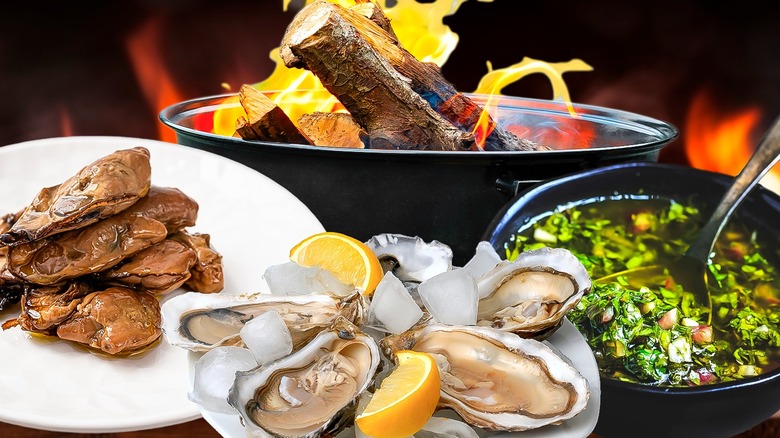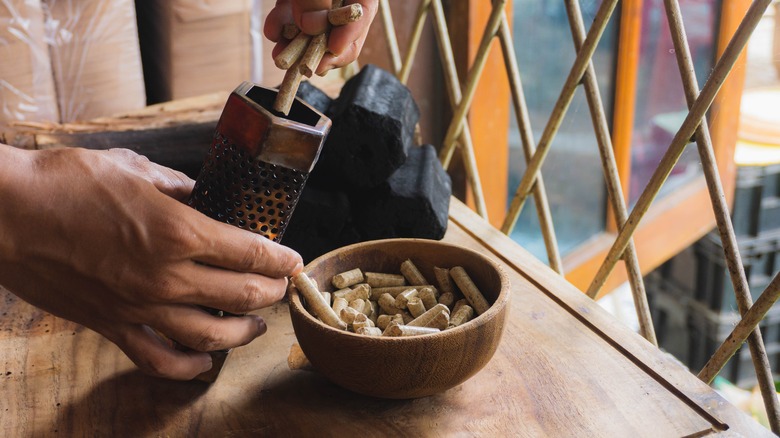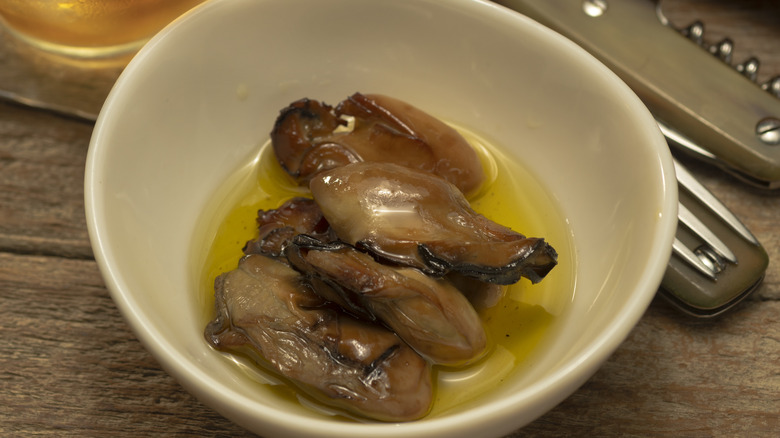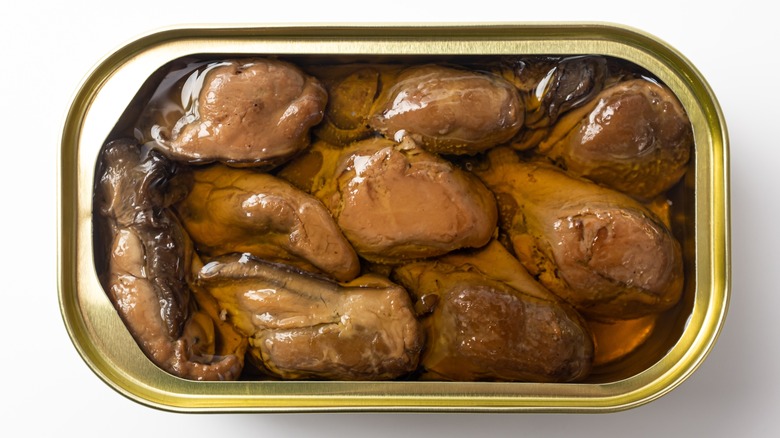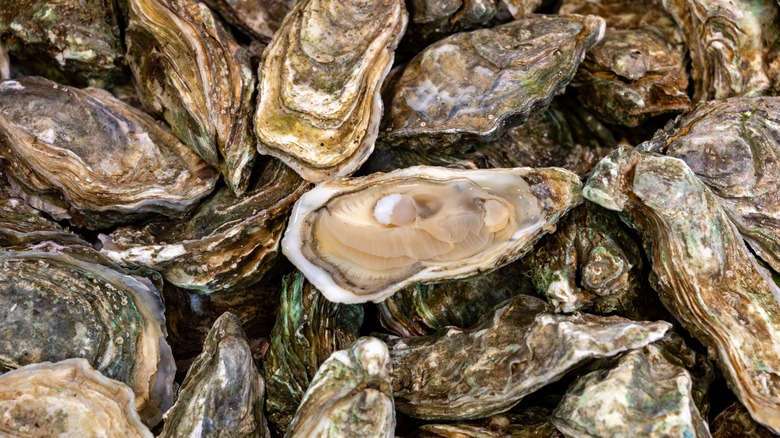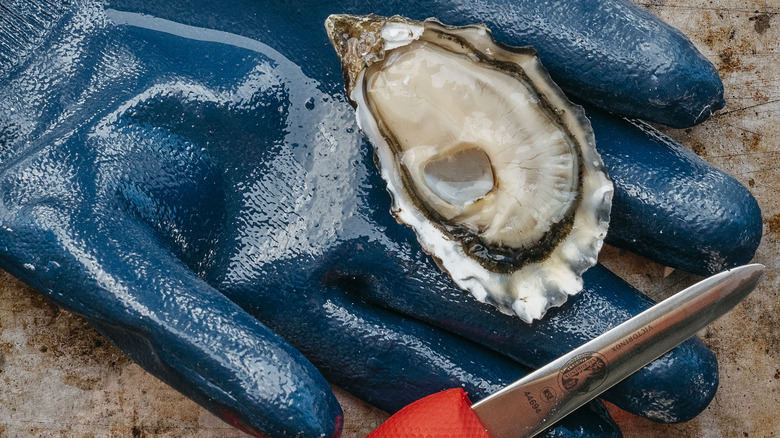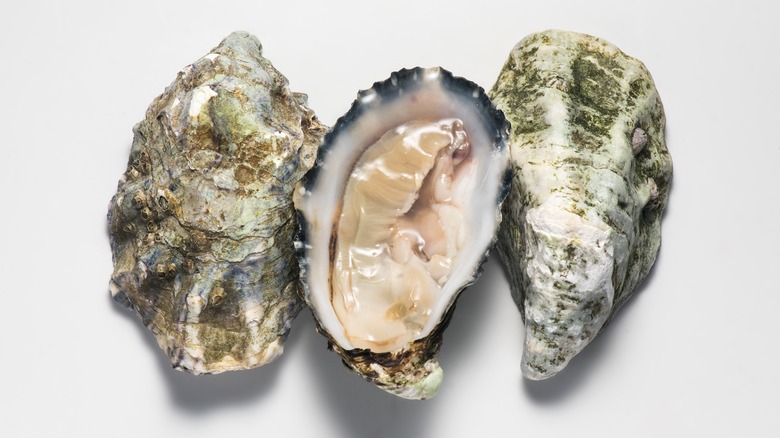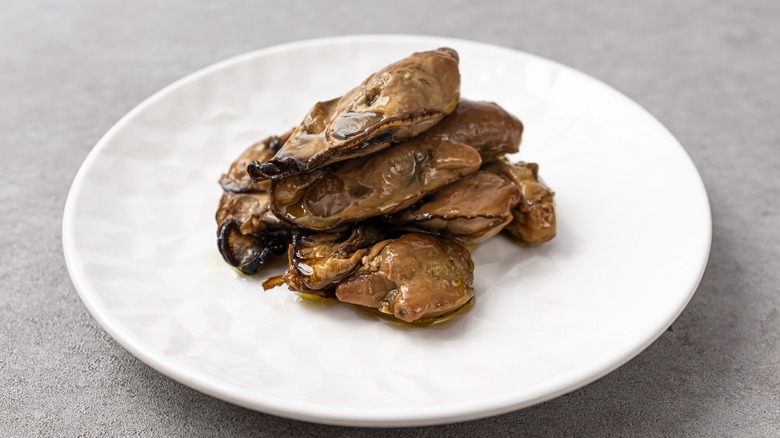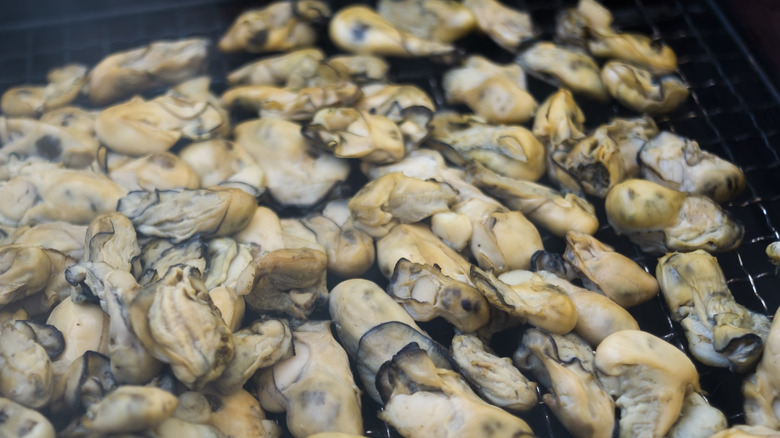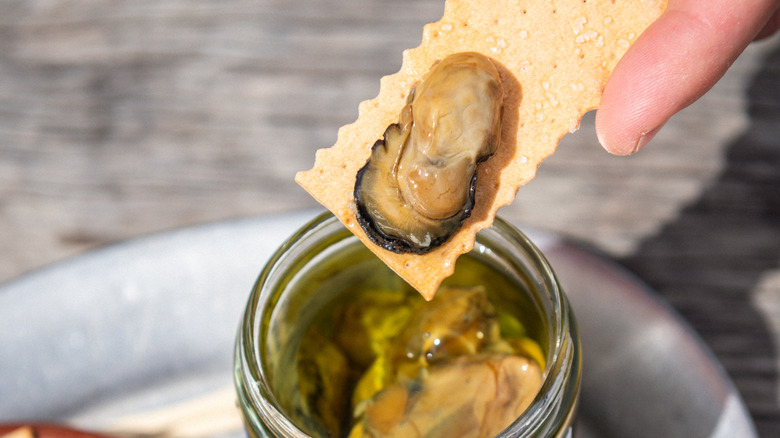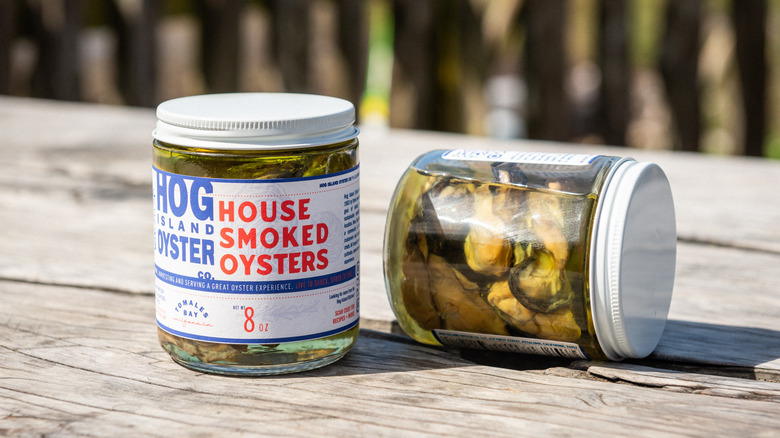11 Mistakes To Avoid When Smoking Oysters, From A California Oyster Farm
There's a common myth that prevails over the world of fresh oysters: that eating them raw is the only way to enjoy them. But we're here to say that this just isn't the case. In fact, you might just find that one of the best ways to eat oysters is by smoking them. If you've got access to a meat smoker, you're opening up a brand new world for yourself when it comes to eating oysters. You won't even need to use a smoking pan for smoked oysters — if you like, you can smoke them shucked and right on a wire rack.
Smoked oysters tend to be much more flavorful than raw oysters. They're salty, meaty, smoky, and can even be slightly sweet depending on the wood you choose. All of these components make smoked oysters the perfect choice for adding to pasta, enjoying with crackers, turning into a dip, or even enjoying all on their own.
If you haven't smoked oysters before or have tried your hand at smoking oysters but find that they just aren't turning out quite right, you're in the right place. We spoke with Lauren Kiino, the culinary director at Hog Island Oyster Co., a sustainable, California-based oyster farm that covers over 200 acres of land and produces five varieties of oysters. Hog Island also produces its own smoked oysters, a process Kiino used to give us insight into what to know about smoking them. Here are our Hog-Island-approved tips on the mistakes you might be making when smoking oysters.
Using the wrong type of wood for your oysters
When it comes to smoking oysters, the first step is to choose the right kind of wood. If you've got a meat smoker at home, you may already have some wood chips on hand, but it's important not to use just any type. Hog Island's Lauren Kiino doesn't recommend using common smoking woods like mesquite or hickory. Though these kinds of woods are favored when it comes to smoking heavier meat like pork, the flavor and aroma of these hardwood is too strong for most seafoods. It will overpower your oysters and might even make them taste bitter.
If you want to get the best flavor out of your smoked oysters, Kiino recommends using a fruit wood. Fruit woods are hardwood chips too, but they're ideal for imparting a lighter, underpowered flavor to your oysters. Generally, any common fruit wood you can get your hands on will be suitable for smoking oysters; like apple or cherry. Fruit woods like cherry may give the lighter color flesh of oysters some darker tint, but will help bring out the natural flavor of your smoked oysters, too.
Smoking your oysters at too high a temperature
What's the most common mistake a person can make when they're smoking oysters? Hog Island's Lauren Kiino says it's pretty simple: parching them. Even if you've smoked other types of meat before, oysters are small — and though they're easy to smoke at home, this can often lead home chefs to accidentally turn the temperature too high. If you're noticing that your smoked oysters turn out dry, rubbery, and with tensely curled edges, this is likely the cause.
So, what's the secret to keeping your smoked oysters moist and juicy? Kiino has plenty, but the first rule of thumb is to keep your smoking temperature nice and low when it comes to oysters. If you want to leave them tasting fresh, you should start right around 200 degrees Fahrenheit or lower. Though this can vary slightly depending on the kind of smoker you're using.
Smoking your oysters for too long
If you've turned down the temperature on your smoker but are still producing dry oysters, there's another reason. You're overcooking your oysters, but this time it's right temperature, wrong time. Oysters don't take very long to smoke — another benefit of doing it yourself, but Lauren Kiino recommends you "smoke the oysters at a low temperature for two hours."
To tell when your oysters have been cooked through, they should be slightly brown on the outside, have gently curled edges, and should not be too soft. If your oysters are wet or gummy inside, you haven't cooked them for long enough. You should check the inside temperature of your oysters with an internal thermometer — generally, you'll want your oysters to be at about 150 degrees Fahrenheit before consuming. Though it is safe to eat certain oysters raw, when smoking them, they need to be cooked with proper food safety in mind.
Not checking for freshness
A big mistake that can be made when smoking oysters is using shellfish that haven't been kept fresh. When you smoke oysters, you need to remove them from their shells before they're cooked, which requires boiling and shucking. If you're boiling oysters in their shells until they're cooked through, it's easy to tell when they've gone bad. But smoking requires you to work with still-living oysters, and that can make it trickier to spot a bad one.
Working with fresh oysters means they need to be alive up until they're ready to be brined. Your number one sign of a bad, un-shucked oyster is if its shell is open. This means that the oyster has died and needs to be thrown out. After you've sorted through the unopened bivalves, keep them fresh with proper storage. To keep your oysters fresh in their shells, cover them with a damp towel and place them in the fridge until you're ready to use them. They'll last up to a week, though it's better to use them sooner than later. It's best not store them over or under ice, and beware that oysters will die if stored in fresh water.
You can also smell check your oysters to see if they've gone bad. The general rule when it comes to seafood is that seafood should smell like salt, but it shouldn't smell fishy. If there's a smell to your oysters that isn't light as ocean breeze, it's time to throw them out.
Not shucking your oysters
To ensure that your oysters cook properly in the smoker, you'll need to shuck your oysters before smoking them. This will allow them to cook thoroughly and evenly. This will also give you the chance to brine and glaze your oysters before you smoke them — something you can't do if they're still live in their shells.
Not shucking your oysters before you smoke them makes it more likely that you'll undercook them. With the oysters still in their shells, they're more likely to cook unevenly and will be protected from cooking all the way through — even if you leave just a half shell on your oysters. Plus, you'd also miss out on achieving the perfectly smoky flavor from the wood if you were to leave the shells on.
To shuck the oysters by hand, you'll need a towel and a sharp knife. The secret to fresh oysters is, of course, that they're alive: this means you'll need to use force to pry open the shell and separate the oyster. Keep your oysters un-shucked until you're ready to pop them in the smoker. Then, scrub off the outside of the shells to remove unwanted dirt and mud. Once you're ready to start the smoking process, it's time to shuck your oysters.
Not batch shucking your oysters
Not a fan of shucking oysters by hand? To be honest, neither are we. Especially if you're planning on smoking a large batch of oysters, nothing seems more daunting than a huge bucket just waiting to be shucked. If you want to save your shucking practice for later, there is a secret hack that you can use to make shucking oysters a little bit more straightforward.
All you'll need to shuck your oysters in a batch is a pot of boiling water. Dip your un-shucked oysters straight into the boiling water for at least a few seconds until the shell begins to pop open. This way, you won't need to force the shell open yourself with a knife, which is the most tedious part of shucking oysters. Don't leave the oysters in the pot of water for too long, though — you should drop them in and remove them all at once very quickly, to prevent them from cooking inside their shells.
After you've removed them from the boiling water, you should blanch them. This will help stop them from continuing to cook inside their shells. After the shells have started to open up, you can pry them open, cut the oysters out of their shells, and begin the smoking process. You can also save the shells after shucking for a fancy way to plate your smoked oysters.
Drying out your oysters while smoking
When you use the right smoking temperature for your oysters and don't cook them too long, you shouldn't notice them drying out at all. But to add in a little extra moisture to your smoked oysters, According to Lauren Kiino of Hog Island says that you can place a small pan of ice in the chamber of your smoker to help keep them even juicer while they smoke.
Keep in mind that you're not trying to cold smoke your oysters here — you want to have just enough ice to allow it to slowly evaporate over the course of your oysters' smoking time. The evaporation from the pan will keep your oysters much more moist than they might have been otherwise.
Adding an ice pan to your smoker is not a necessity, so if you're still getting the hang of smoking your oysters, you may decide to smoke a batch without any extra steps. But if you want to try adding extra flavor and moisture to your oysters, adding a pan of ice to the chamber is an expert-approved way to go.
Not brining your oysters
Though seafood enjoyers love the natural salty taste of smoked oysters, that doesn't mean you should completely skip out on brining them. According to culinary director, Lauren Kiino, Hog Island always brines its oysters prior to smoking them for the jarred product it sells online and at California farmers markets.
It's not just about the flavor when it comes to brining smoked meats. Brining your oysters before they smoke will ensure that they retain moisture throughout the entire smoking process. Even better, brining your meat before cooking it can actually help it cook more evenly. Just make sure your oysters are fully shucked before submerging them in brine.
You don't need to opt for a complicated brine in order to make a successful batch of smoked oysters. Most brines will include a mix of water, salt, sugar, and herbs and spices. Just make sure you're going for a wet brine, not a dry one! The extra moisture is much needed for your oysters — and you'll probably find it easier to batch wet brine them rather than try to dry brine them. Because oysters are so small, you won't need to brine them for very long before they're ready to go — a few hours can be all you'll need. Though brining your oysters before smoking them will not extend their preservation time, it's worth it for the flavor and texture you'll get from them in the end.
Smoking your oysters right after brining
Once you've finished brining your oysters, you shouldn't put them in the smoker right away. First, you'll need to remove them from the brine and allow them to dry off a little bit. Hog Island's Lauren Kiino says that you should "allow the oysters to air-dry in the fridge after taking them out of the brine. That will help the smoke stick."
You can keep the oysters in the fridge until they've dried off a bit, checking on them regularly to see when they're ready to be smoked. Make sure to transfer them directly from the brine back into the fridge — uncooked oysters should not be left out at room temperature.
Allowing the brine to dry onto the oysters will prevent them from retaining too much moisture, giving them a chance to cook thoroughly while still staying juicy. This also allows the oysters to soak up as much brine as possible as they dry. It might even give you a better smoke flavor and texture on the exterior of your smoked oysters. Though giving your oysters a chance to dry after brining them might seem counter-intuitive, Kiino says it's all about achieving that deliciously smoky flavor everyone loves.
Not glazing your oysters
So, you've brined your oysters, let them dry, and are ready to start smoking them — well, almost. Hog Island both brines and glazes their oysters. And yes, this will not only give your oysters extra flavor, but will also keep them moist while they're being smoked — have you caught onto a pattern here yet?
Unlike with brining, you won't glaze your oysters for a long time before they're ready to be smoked, so there's no need to worry about glazing them ahead of time. Once you've brined your oysters, fire up your smoker and get your glaze ready. Then, you can brush a glaze over your oysters right before they go into the smoker.
As soon as you've added your glaze of choice, insert the oysters into the smoker. The glaze will cook onto the oysters, giving them a quick extra punch of flavor as they begin the smoking process. Smoke sticks to moisture, so adding a glaze on your oysters will help them retain even more smoky flavor. It will also help them retain moisture without changing them too much texturally. Even when it comes to the flavors of your glaze, simple is usually better — the goal is to bring out the natural salty flavor of the smoked oysters, not hide it with a complex glaze. You can pre-buy smoking glazes or make one yourself — common ingredients include sugar or honey, soy sauce, spices, and/or water.
Storing your smoked oysters improperly
If you've purchased smoked oysters from the store before, you'll likely have noticed that they're usually stored in a jar of oil. When you smoke them at home, that's exactly how you should store them to keep them fresher for longer. Just cover the oysters in oil and pop them in a jar or another airtight container before refrigerating them.
Freshly smoked oysters can keep up to a week in the fridge once they've been placed in oil (as long as they're in an airtight container, of course). You can also freeze smoked oysters if you're planning on keeping them for longer, though some oyster fanatics argue that frozen oysters have a slightly different texture once thawed. Regardless, everyone can likely agree that one of the best parts about enjoying homemade smoked oysters is getting to eat them right away.
Although smoking is a great way to preserve certain kinds of meats, smoking oysters won't actually preserve them (nor will it make them shelf-stable). If you're uncertain about whether or not the smoked oysters you've been storing are still good to eat, inspect them visually and smell them. If there are any unusual odors, if they smell overly fishy or 'off', or if you see any signs of spoilage (like mold) don't hesitate to throw out the batch.
